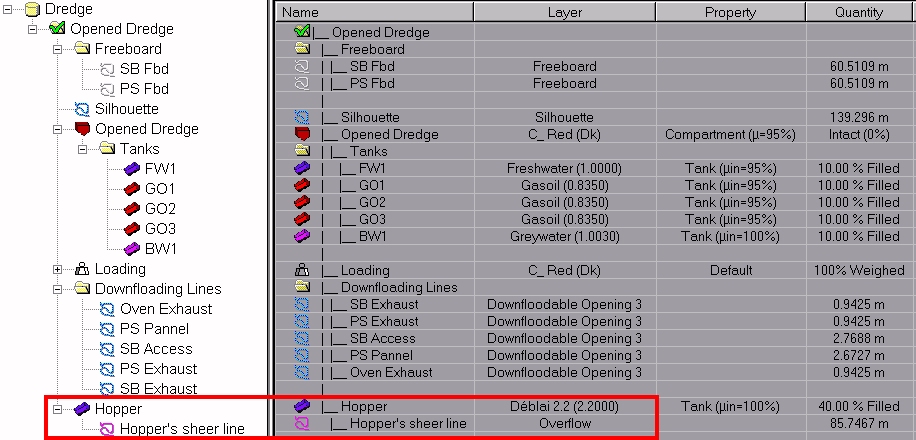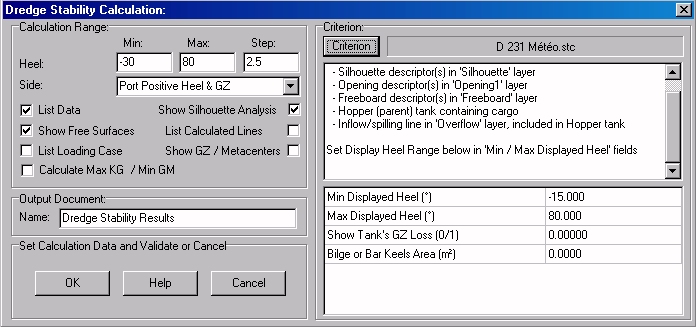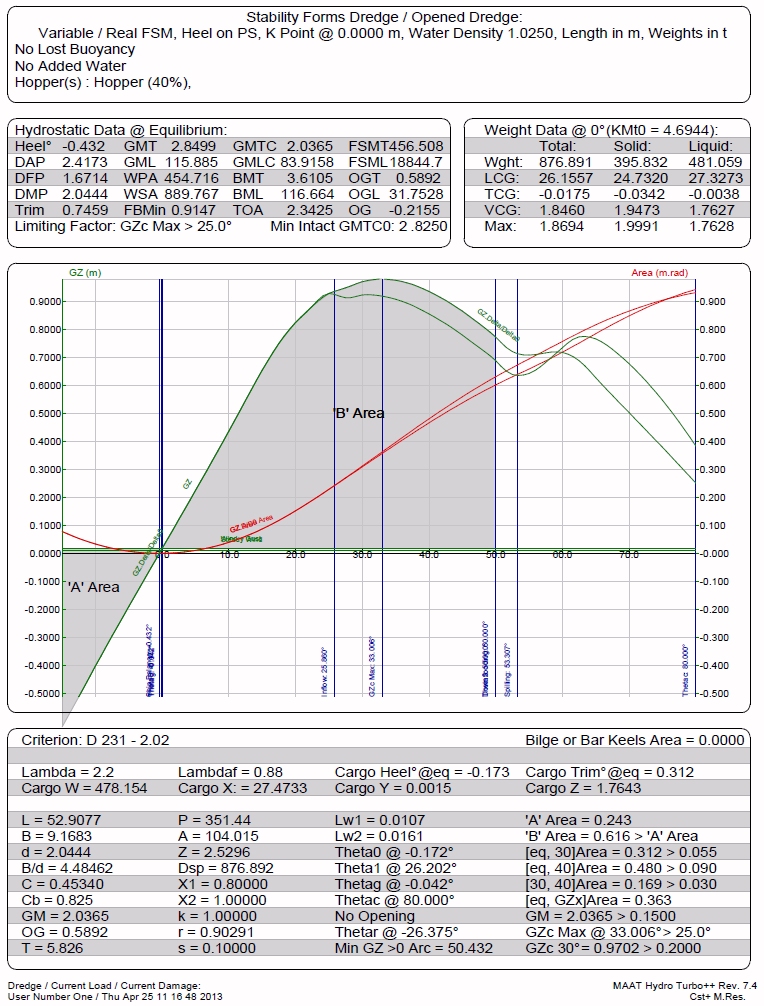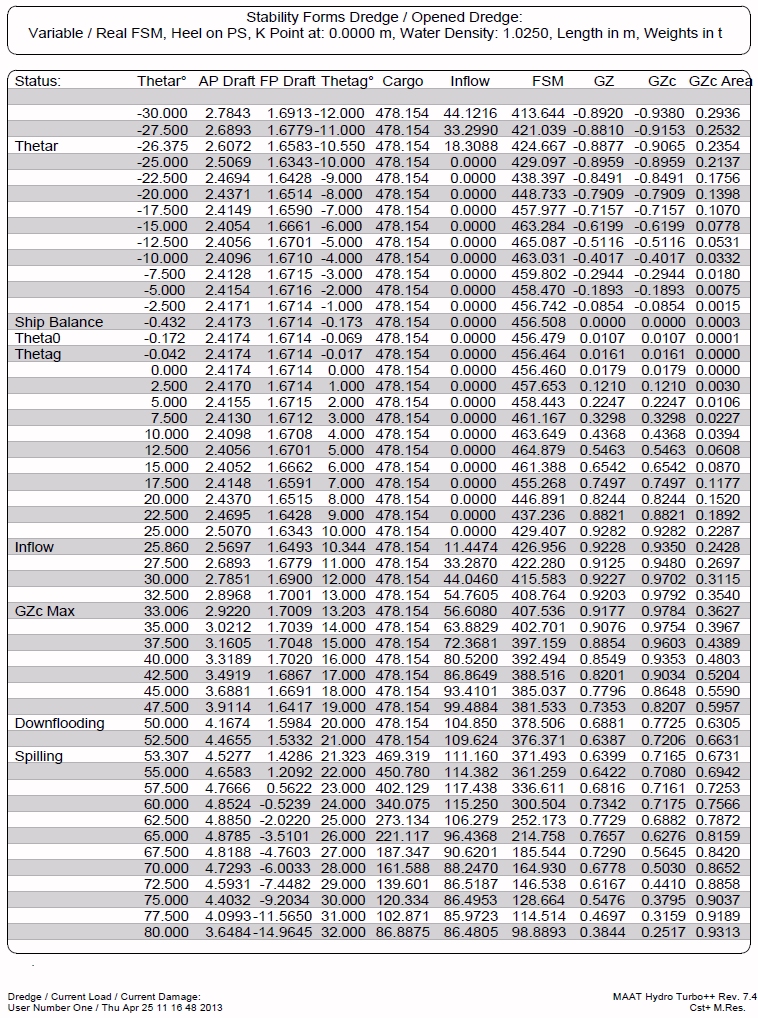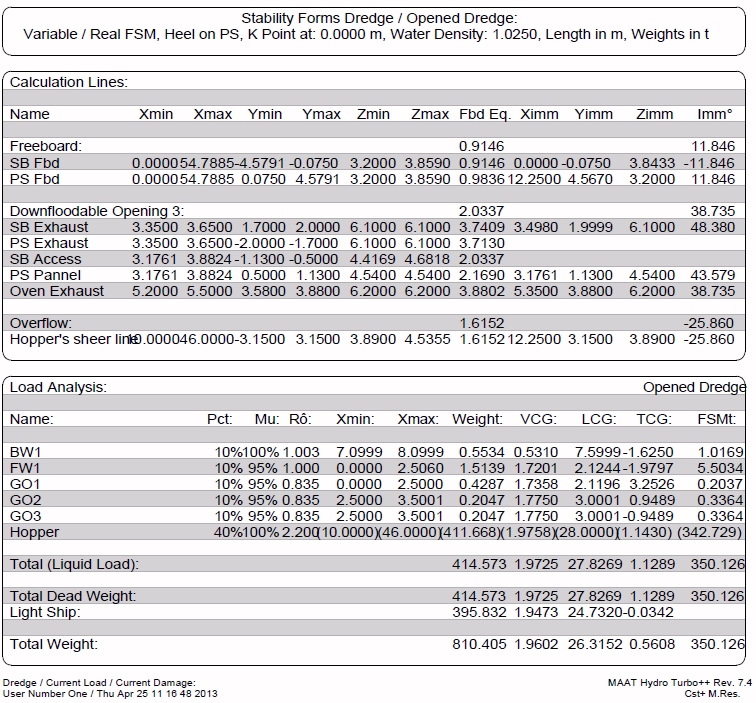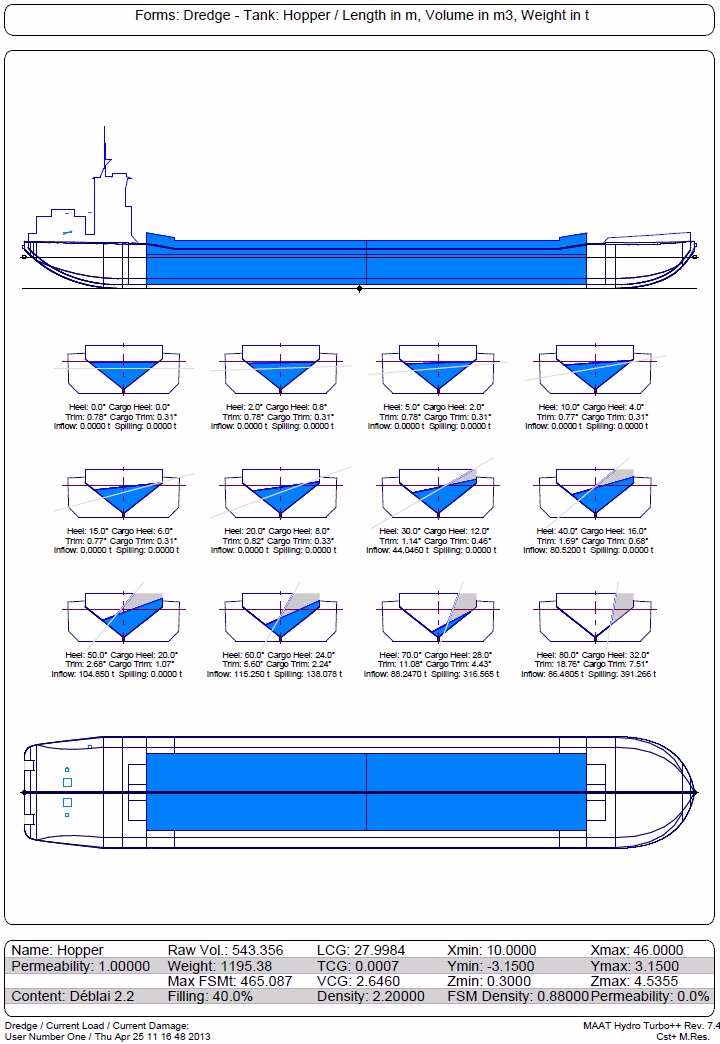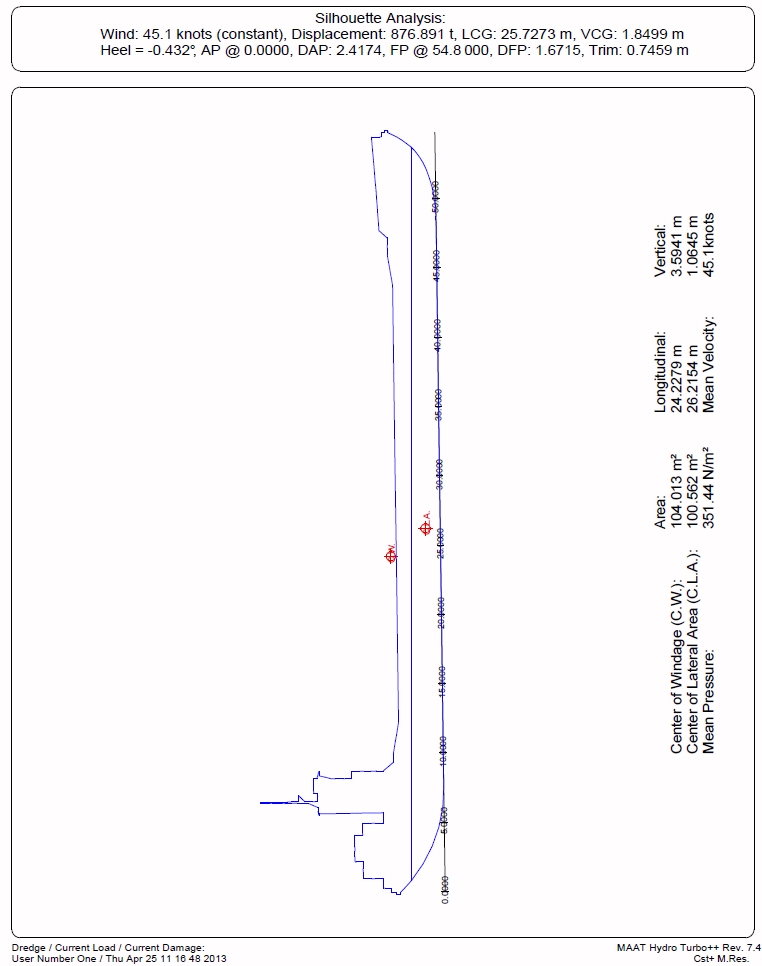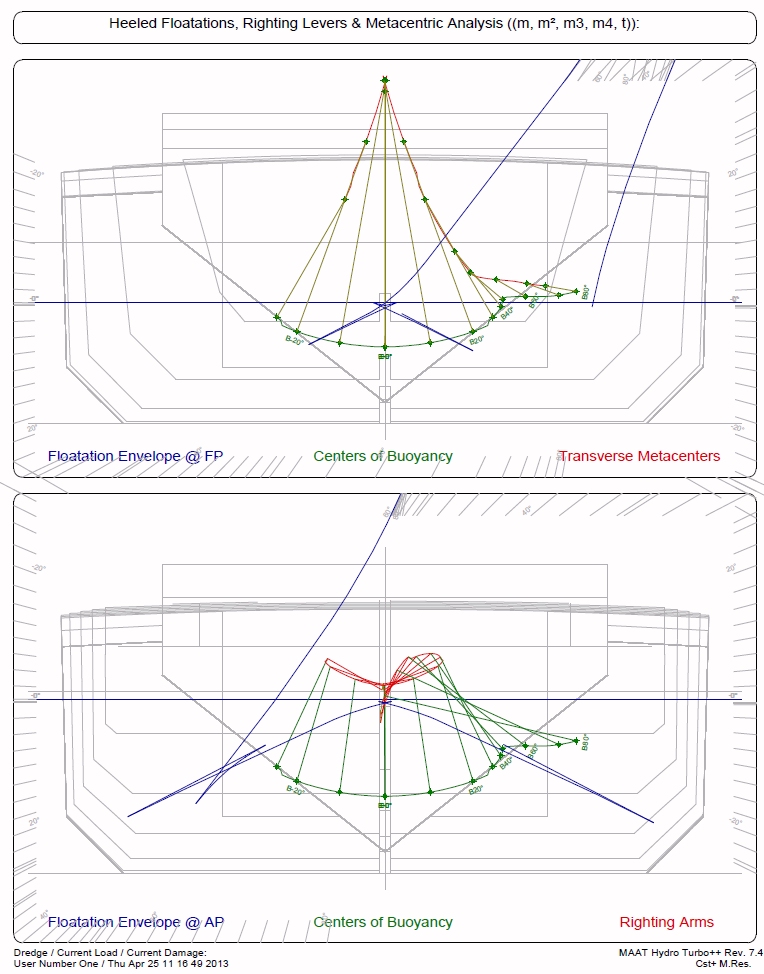Menu bar/Tools/Dredge Stability
____________________________________________________________________________________________________________________
Purpose:
Dredge stability calculation is based on 4 simultaneous phenomenons:
- Cargo shifting, whose free surface is not parallel to floatation (cargo’s heel is defined according to its density and floatation’s heel in criterion script’s header).
- Cargo’s progressive spilling out of hopper, depending on heel and hopper’s spilling / inflow line.
- Inflow (with possible spilling) by hopper's spilling line (identified in the 'Overflow' layer), depending on cargo’s free surface, permeability and line's immersion.
- Inflow (without spilling) by hopper's inflow openings -i.e. hopper's bottom lines when not watertight- (identified in the 'Downflooding Opening 1' layer), depending on their immersion.
The dedicated ‘Dredge Stability’ function automatically processes these 3 phenomenons, which are not supported by the standard ‘Transverse Stability’ function (so, don’t try calculating dredge’s stability with the ‘Transverse Stability’ function and don’t try calculating a standard stability with the ‘Dredge Stability’ function).
In order to make this automatic process possible, a few simple modelling rules must be respected (see the FAQ for more details) and the selected criterion must include a special header specifying cargo’s properties (see the the ‘D231.stc’ header criterion for example).
Dredge stability calculation is refused if current ship doesn’t comply with the required modelling rules (i.e doesn’t contain a ‘hopper tank’ set in the ‘Dredge Cargo Layer’ and an affiliated hopper inflow / spilling sheer line set in the ‘Overflow Layer’, as shown below).
- Similarly, inflow (without spilling) lines must also be included and set in the 'Downfloodable Opening 1' layer if necessary (i.e hopper's bottom when not watertight). Cargo's permeabilty can be specified in the 'Permeability' column of [Ship] tab's [Material] page.
Inputs:
The following dialog box pops up when the function is selected:
The [Criterion] button allows selecting the dredge stability criterion among the available STC scripts (the associated data must be set after this selection). As explained above, the selected criterion must include a special header specifying cargo’s properties (see the the ‘D231.stc’ header criterion for example).
The ‘Heel Range’ ‘Min’, ‘Max’ and ‘Step’ fields allow defining the stability heel range to calculate. This range must, of course, be thought in order to allow calculating the selected criterion.
The ‘Side’ selector allows defining on which side the stability has to be calculated.
The ‘List Data’ check box allows including / removing the stability data listing associated to the diagram (see below).
The ‘Show Free Surfaces’ check box allows including / removing the Cargo / Floatation free surface report (see below).
The ‘List Loading Case’ check box allows including / removing current loading condition’s analysis (see below).
The ‘Calculate Max KG / Min GM’ check box allows including / removing the Max KG corresponding to the selected criterion in stability diagram’s header (see below).
The ‘Show Silhouette Analysis’ check box allows including / removing the Silhouette analysis diagram at equilibrium (see below). These data correspond to ‘/Tools/Silhouette Analysis’ report.
The ‘List Calculated Lines’ check box allows including / removing the information (dimensions, freeboard at equilibrium, angle of immersion) concerning the current freeboard and openings descriptors (see below).
The ‘Show GZ / Metacenters’ check box allows including / removing the Body plan / GZ polar / Metacenters curves (see below).
The ‘Output Document Name’ input field allows naming the 2D folder in which the resulting reports will be created in the 2D browser.
At last, when all the stability input data are set:
The [OK] button can be clicked for calculating ship’s data and creating the corresponding report. Nevertheless, as this calculation may be time consuming, a confirmation box recalls the number of stability calculations before starting.
The [Help] button allows displaying the online help (Internet access necessary).
The [Cancel] button allows cancelling the calculation.
Pressing the [Escape] key when calculation is started allows aborting it.
Outputs:
The Dredge Stability outputs are the followings:
Typical Dredge Stability Curve:
Typical Dredge Stability Listing:
Line and Load Analysis:
Free Surfaces Analysis:
Silhouette Analysis:
GZ / Metacenters Diagram:
Limitations:
The calculated model must comply with the dredge modeling rules respected (see the FAQ for more details) and be realistic in terms of weight and buoyancy.
Typical use:
Calculating dredge’s stability.
Example:
- Open a dredge file complying with the dredge modeling rules and select it to calculate its stability data:
- Select '/Tools/Dredge Stability' in the menu bar.
- Click on the [Criterion] button, select the ‘D231 Météo’ dredge criterion and validate it.
- Click on the [OK] button and check the obtained reports.

